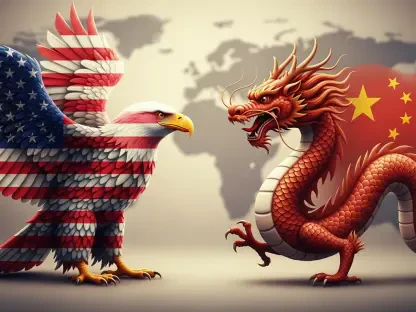The pharmaceutical industry is witnessing a critical surge in prices for Metoprolol Succinate, a vital medication prescribed to manage conditions such as hypertension, angina, arrhythmia, heart attacks, and migraines. The notable price escalation began early in March and has shown signs of persisting through the month. Several factors have converged to drive this upward trajectory, including a significant rebound in China’s manufacturing sector, marked by an increase in the Manufacturing PMI to 50.2 in February, up from 49.1 in January, signaling growing demand from both pharmaceutical and industrial sectors.
Economic Impact of China’s Manufacturing Rebound
Influence of Manufacturing PMI Growth
A closer examination of the economic factors reveals that the rise in Metoprolol Succinate prices is intricately linked to China’s improved manufacturing outputs. When the Manufacturing PMI crosses the pivotal 50 mark, it signifies expansion within the sector, indicating more pharmaceutical products being channeled into various industries. Coupled with this surge is a rising demand for Metoprolol Succinate, leading manufacturers to ramp up production capacities to meet this heightened need.
This scenario has created a chain reaction. As Chinese manufacturers boost production, the need for raw pharmaceutical materials skyrockets, increasing acquisition costs. This supply chain ripple effects, raising price points along the distribution journey. Restocking activities post-Lunar New Year further amplify these pressures, as suppliers replenish their dwindled inventories to balance out extended holiday closures. Thus, the price climb is a composite result of increased demand and procedural restocking efforts, setting a foundation for sustained high prices.
Raw Material Procurement and Cost Dynamics
The deflationary trends prevalent in China have exacerbated the situation by elevating procurement volumes for pharmaceutical raw materials. When deflation lowers prices temporarily, buyers tend to swoop in, making bulk purchases to capitalize on reduced costs. However, this buying frenzy pushes up demand, which then reverts to higher price levels as stocks diminish. Pharmaceutical manufacturers are not immune to these market dynamics. They find themselves grappling with inflated costs as they source necessary ingredients for Metoprolol Succinate production, trickling down to end consumers who face steep prices at the pharmacy counter.
Moreover, larger pharmaceutical firms with diversified portfolios redirect focus to high-demand drugs, restocking them extensively. This strategic stockpiling accentuates the scarcity of Metoprolol Succinate in various markets, indirectly promoting a price surge. Such practices pinpoint the interplay between market mechanisms and price inflation, offering a layered understanding of how individual business strategies contribute to broader economic impacts within the pharmaceutical sector.
Trade Policies and Their Market Ramifications
Impact of U.S.-China Trade Tensions
Trade policies play a notorious role in shaping the market dynamics for pharmacological supplies like Metoprolol Succinate. The U.S.’s imposition of a 10% tariff on Chinese imports, reciprocated by China with equal tariffs on American goods, has injected a wave of volatility into global trade practices. These tariffs distinctly affect the drug’s production and distribution, adding an extra layer of cost that manufacturers reluctantly pass onto consumers. Consequently, both U.S. and Chinese markets experience price hikes, reflecting the broader economic trend fueled by protectionist trade strategies.
Such trade restrictions also foster an environment of reduced international demand. When tariffs inflate prices, buyers, particularly smaller firms with limited budgets, may reduce their procurement quantities or seek alternative markets. This disruption to international trade forebodes supply chain unpredictability, compounding the complexities for major market participants and affecting their buying sentiment adversely. The influence of these tariffs extends beyond immediate price bumps to long-term market dynamics, ultimately shaping the global pharmaceutical landscape.
Steady Demand Versus Trade Uncertainty
Despite these trade-related headwinds, a robust demand for Metoprolol Succinate persists, mainly driven by recovering manufacturing activities in key regions like China. Pharmaceutical companies are steadily increasing their procurement efforts to ensure an uninterrupted supply, buoyed by positive market indicators from the manufacturing sector. This unwavering demand underscores the fundamental role that essential medications like Metoprolol Succinate play in global healthcare, providing a degree of resilience against volatile economic conditions.
Conversely, the continuous interplay between steady demand and trade-induced uncertainty necessitates diligent monitoring by market observers. Companies remain vigilant, tracking fluctuations in supply chains, inflation rates, and international trade policies to make informed decisions. As demand maintains its stronghold, understanding the multifaceted developments that contribute to the drug’s pricing trajectory becomes imperative for stakeholders at all levels.
Future Implications and Perspectives
Anticipated Market Trends
Looking forward, the bull market trend is expected to continue for Metoprolol Succinate, driven by the concurrent recovery of the manufacturing industry and heightened pharmaceutical demand. Market participants anticipate further fluctuations directly tied to ongoing economic policies and procurement strategies. As Chinese and global markets evolve, the landscape for Metoprolol Succinate prices will invariably reflect these transformations. The industry’s challenge lies in balancing consumer needs with market realities, ensuring sustained affordability and access to life-saving medications.
Strategic Considerations for the Future
The pharmaceutical industry is currently experiencing a significant increase in the prices of Metoprolol Succinate, an essential medication used to treat various conditions such as hypertension, angina, arrhythmia, heart attacks, and migraines. This notable price surge started in March and appears likely to continue throughout the month. Several factors have contributed to this upward trend, one of which is the notable resurgence in China’s manufacturing sector. For instance, China’s Manufacturing PMI (Purchasing Managers’ Index) rose to 50.2 in February, up from 49.1 in January. This indicates a growing demand for both pharmaceutical products and industrial goods, further driving prices higher. The combination of increased demand and a strengthening manufacturing sector has resulted in a persistent rise in Metoprolol Succinate prices, impacting both the pharmaceutical industry and patients relying on this vital medication.









